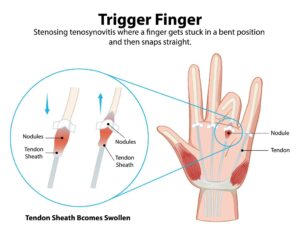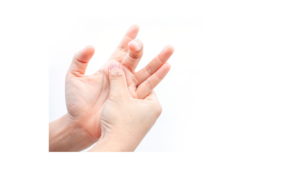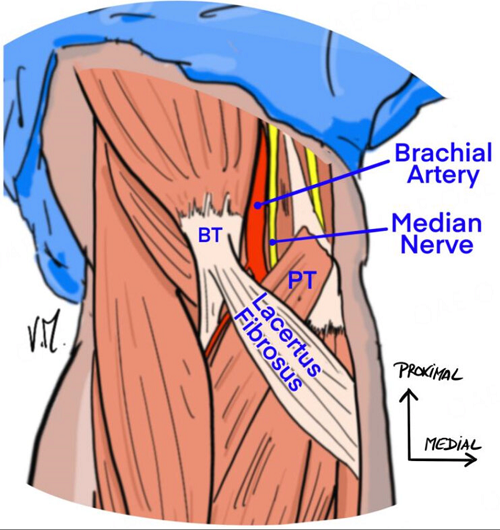
What Is Trigger Finger?
Have you ever had a finger lock in place, followed by a sharp snap of pain when trying to straighten it? These are typical symptoms of Trigger Finger, also called snap finger. In this guide, Dr. Marouane Bouloudhnine, Dubai’s top hand surgeon with 30+ years of experience explains Trigger Finger, its causes, and the best ways to treat it.
What Is Trigger Finger?
Trigger Finger, or Stenosing Tenosynovitis, occurs when tendons in finger become inflamed. This causes the finger to lock in a bent position and snap when straightened. A small nodule often forms on the tendon restricting smooth movement within the tendon sheath.

Key Features of Trigger Finger:
- Nodule: Thickened area at the base of the finger.
- Locking: The finger gets stuck in a bent position.
- Popping: Snapping or clicking sound when the finger straightens.
The ring finger is most commonly affected, followed by the thumb and middle finger.
What Causes Trigger Finger?
Several factors lead to Trigger Finger:
- Repetitive gripping: Jobs involving frequent hand use, like typing or playing instruments, increase the risk.
- Rheumatoid arthritis or diabetes: These conditions damage nerves and reduce blood flow, making Trigger Finger more likely.
- Injury: Trauma to the hand inflames tendons and triggers the condition.
Symptoms of Trigger Finger
Symptoms can be mild or severe and include:
- Morning stiffness in the finger.
- Clicking or popping sensation when moving the finger.
- Pain at the base of the affected finger.
- Locked finger in a bent position, suddenly snapping straight.
Trigger Finger Test

To test for Trigger Finger, try bending and straightening your affected finger. If it locks or causes pain, this may be a sign. Your doctor may also press the palm to detect tenderness or a lump.
What to Do for Trigger Finger
Early intervention prevents worsening symptoms. Here’s what you can do:
- Rest: Reduce repetitive hand movements.
- Splinting: Wearing a splint keeps the finger straight and reduces strain.
- Ice/heat therapy: Alternating between cold and warm compresses can reduce swelling.
Trigger Finger Exercises
Gentle exercises can help restore movement. Try these:
- Finger Stretch: Lay your hand flat and lift each finger individually.
- Tendon Gliding: Bend your finger joints, forming a hook shape, then straighten them slowly.
- Finger Lift: Place your hand flat and lift one finger at a time.
What Is the Best Medicine for Trigger Finger?
Medication can relieve pain and inflammation. Common treatments include:
- NSAIDs: Over-the-counter drugs like ibuprofen reduce swelling and pain.
- Corticosteroid injections: These are highly effective at reducing inflammation around the tendon.
If conservative treatments don’t work, surgery may be recommended to release the tendon and restore movement.
Prevention Tips for Trigger Finger
One can reduce the risk by:
- Ergonomic Adjustments: Ensure your workspace minimizes hand strain.
- Proper Hand Care: Keep hands moisturized and avoid irritants.
- Strengthening Exercises: Regular hand exercises can improve strength and flexibility.
- Manage Underlying Conditions: Control conditions like diabetes or arthritis to reduce your risk.
Dr. Marouane Bouloudhnine: Dubai’s Expert in Hand and Shoulder Surgery
Dr. Marouane Bouloudhnine is a leading hand and shoulder orthopedic surgeon with over 30 years of experience. Based in Dubai, Dr. Marouane is recognized for his expertise in treating Trigger Finger and other hand conditions. His approach combines non-surgical methods and minimally invasive surgery, tailored to each patient’s needs.
If you have Trigger Finger or other hand problems, Dr. Marouane provides specialized care and guidance for the most effective treatment options.
FAQs About Trigger Finger
- Can Trigger Finger heal on its own?
Mild cases may improve with rest, but persistent cases usually need treatment. - How is Trigger Finger diagnosed?
Doctors diagnose Trigger Finger through physical exams, focusing on pain and locking symptoms. - Is surgery the only option for severe Trigger Finger?
No, corticosteroid injections and splints are often effective. Surgery is only needed if other treatments fail. But, if the finger remains still blocked since many days, the surgery could be the first option. - What happens if Trigger Finger is untreated?
Untreated cases can worsen, leading to permanent finger stiffness and flexor tendon laceration. - How long is recovery after Trigger Finger surgery?
Recovery usually takes a few weeks, with full function restored in 6-9 weeks.
Conclusion
Trigger Finger limits hand function and causes significant discomfort, but early diagnosis and proper treatment lead to a full recovery. Whether through exercises, medications, or surgery, there are various ways to manage Trigger Finger effectively.
If you’re experiencing symptoms, consulting with a specialist like Dr. Marouane Bouloudhnine ensures you receive expert care for lasting relief.
“Your Hand Is Our Priority”–Dr. Marouane Bouloudhnine, expert hand-to-shoulder surgeon.






